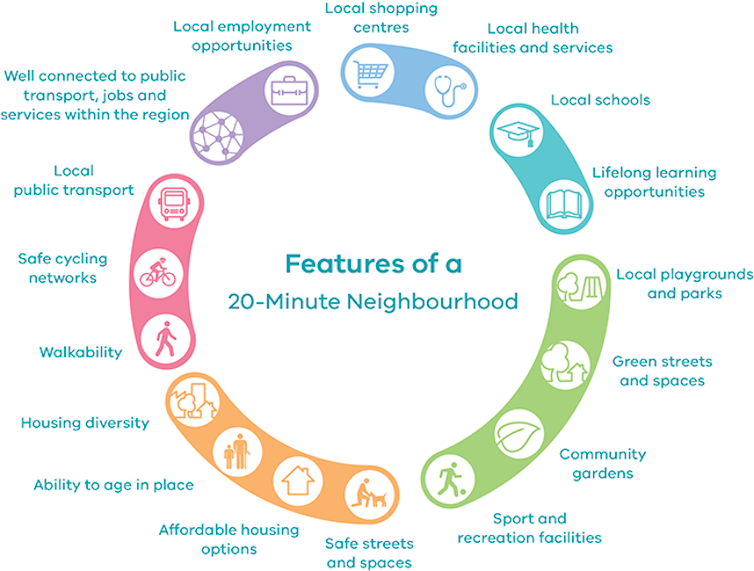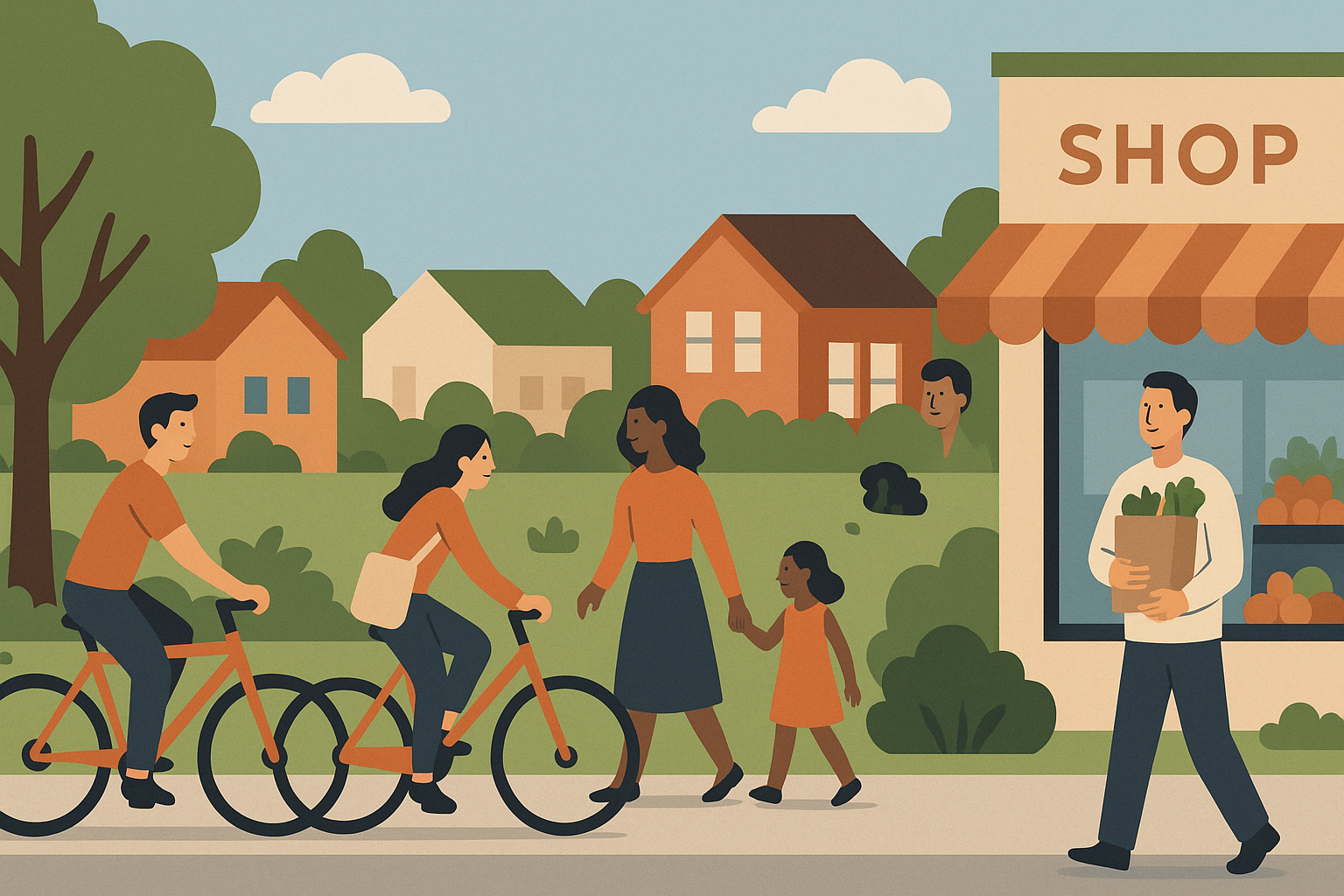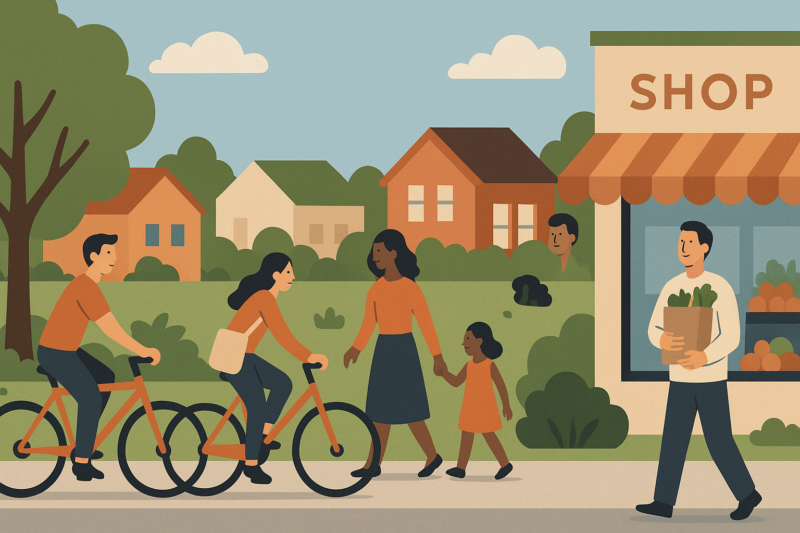
Key takeaways
The 20-minute neighbourhood concept is growing in relevance, with a focus on lifestyle convenience and accessibility to daily needs.
Work-from-home trends and hybrid working have intensified the demand for living in communities that provide easy access to amenities.
Suburbs with local facilities are seeing greater property demand, as people value proximity to cafes, parks, shops, and workspaces.
Health, well-being, and social connections are key drivers for choosing 20-minute neighbourhoods.
The trend reflects a shift towards a more localised lifestyle, changing the way Australians view urban living.
In this article I list the 7 key criteria for a great neighbourhood.
Imagine stepping out your front door and knowing that almost everything you need - your local shops, a good coffee, schools, parks, a medical centre, the train station, even local jobs is just a short stroll away.
You don't waste time stuck in traffic.
You don't drive across town for basic errands.
And you feel like you’re truly part of your community rather than a visitor to it.
That’s the promise of the 20-minute neighbourhood, and it's reshaping how Australians want to live — and where property values are rising most strongly.
What exactly is a 20-minute neighbourhood?
In urban planning circles, the term describes a community where residents can access most of their daily needs within a 20-minute return walk (typically within 800 metres).
This includes:
-
A range of local shops and services
-
Public transport
-
Schools and childcare
-
Parks and open space
-
Medical and community services
-
Local employment or co-working options
It isn’t a new concept, but it has gained enormous momentum over the last few years as Australians rethink lifestyle, convenience, work patterns and how they want their neighbourhoods to function.

State Government of Victoria, CC BY
The rise of living locally
One of the biggest social shifts of recent years has been the move toward living, working and playing close to home.
The pandemic accelerated an already emerging trend.
When lockdowns forced people to stay in their neighbourhoods, many discovered the benefits of a walkable life - shorter commutes, more time with family, a stronger sense of community and healthier daily routines.
Even as life returned to normal, the desire to live locally didn't fade. It’s intensified.
Australians increasingly want:
-
Less commuting
-
More flexibility
-
More walkable amenities
-
Local food, local experiences and local identity
-
Community connection
-
Neighbourhoods that feel safe and welcoming
These lifestyle preferences are now influencing where people choose to live and what they are willing to pay for it.
Why these neighbourhoods are in demand
The appeal is clear: a more convenient, sustainable and community-centred way of living.
But there’s more at play.
1. Hybrid work is here to stay
Workers are no longer tied to daily CBD commutes.
People want homes that support remote work but still feel connected to local life. A high-amenity suburb offers the best of both worlds.
2. Time is the new luxury
As people try to simplify life, reducing travel time becomes priceless.
Walkability gives families hours back each week.
3. Environmental and health benefits
Less driving means lower emissions, less noise, cleaner air and more active living.
This improves a suburb's liveability rating, which in turn boosts property desirability.
4. Stronger communities
Local living encourages connections.
You bump into neighbours, support local businesses, and feel safer walking around.
This social fabric enhances the area's appeal.
What makes a strong 20-minute neighbourhood?
Not every suburb with a local shop qualifies.
Research from city planners and the Victorian Government shows that a true 20-minute neighbourhood has:
-
Safe walking and cycling paths
-
High-frequency public transport within a short walk
-
A mix of shops, services and everyday essentials
-
Good schools and childcare
-
Parks and open space
-
Health and community facilities
-
Housing diversity for different life stages
-
Strong local character or identity
-
Local jobs or access to nearby employment nodes
Becoming a 20-minute neighbourhood
Many inner suburbs of Australia’s capital cities and parts of their middle suburbs already meet a 20-minute neighbourhood test.
However, very few of the outer suburbs would do so.
It’s about more than just walkability, for outer suburban areas, creating these neighbourhoods also requires:
-
Higher density (around 25 to 30 dwellings per hectare)
-
Mixed-use development
-
High-quality local centres
-
Better integration of transport and land use
This density isn’t about high-rise towers everywhere. It’s about gentle density: townhouses, medium-rise apartments, shop-top housing and well-designed infill development.
The investment perspective
We know that location will do 80% of the heavy lifting in your property’s performance, and that some locations outperform others by 50% to 100% over a decade in terms of capital growth.
For property investors, the 20-minute neighbourhood trend is far more than a lifestyle shift. It has real economic consequences.
1. Walkability commands a price premium
Numerous studies show that homes close to amenities, public transport and local services consistently outperform the broader market. Australians will pay for convenience.
2. These suburbs attract stable, long-term residents
Tenants and owner-occupiers who value lifestyle and community tend to stay longer, reducing vacancy rates and increasing market depth.
3. Demographic demand is shifting
Younger professionals, families with school-aged children and downsizers increasingly want walkable communities. These demographics have strong spending power and often bid up prices.
4. Better downside protection
History shows that suburbs with strong amenities and lifestyle advantages are more resilient during market downturns. People don’t cut back on convenience, even in tougher economic conditions.
5. Future growth corridors
As governments invest more in local centres, transport upgrades and mixed-use planning, the early stages of 20-minute neighbourhood creation can unlock significant capital growth.
Where the best opportunities will be
The strongest opportunities lie in:
-
Established inner- and middle-ring suburbs already rich in amenity
-
Emerging mixed-use precincts around upgraded train stations or activity centres
-
Suburbs undergoing revitalisation through government or private investment
-
Neighbourhoods adding new schools, medical centres or lifestyle offerings
-
Areas with high walk scores but still affordable entry prices
Investors should look for suburbs where walkability is already strong, or where infrastructure, zoning changes and redevelopment are about to strengthen it further.
A smarter way to think about location
Traditionally, property investors focused on proximity to the CBD, but today, the equation is shifting.
Location is no longer just about distance to the city; it’s about quality of life, confidence in the neighbourhood’s future, and how a suburb fits into new lifestyle patterns.
The 20-minute neighbourhood offers a framework for understanding these shifts.
It helps investors identify suburbs where demand will deepen, amenity will improve and lifestyle will remain central to buyer behaviour.
And as long as Australians continue to crave convenience, community and connected living, these neighbourhoods will remain the winners.















